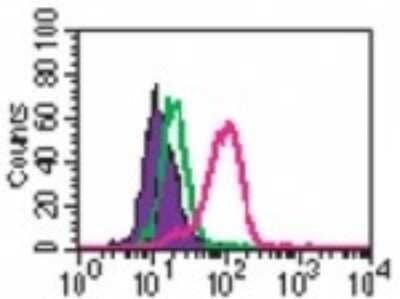TLR9 Antibody (26C593.2) [PE]
Novus Biologicals, part of Bio-Techne | Catalog # NBP2-24907


Conjugate
Catalog #
Key Product Details
Species Reactivity
Validated:
Human, Mouse, Rat, Canine, Equine, Monkey, Primate
Cited:
Human, Mouse, Canine, Primate (Rhesus monkey)
Applications
Validated:
Flow (Cell Surface), Flow (Intracellular), Flow Cytometry, Immunocytochemistry/ Immunofluorescence, Immunohistochemistry, Immunohistochemistry-Paraffin, Knockdown Validated, Western Blot
Cited:
Flow (Cell Surface), Flow Cytometry, Flow Cytometry Control, Immunohistochemistry-Paraffin, Western Blot
Label
PE (Excitation = 488 nm, Emission = 575 nm)
Antibody Source
Monoclonal Mouse IgG1 kappa Clone # 26C593.2
Concentration
Please see the vial label for concentration. If unlisted please contact technical services.
Product Specifications
Immunogen
This antibody was developed against KLH-conjugated synthetic peptide corresponding to amino acids 268-300 of human TLR9 isoform A (Genbank accession no. AAF78037).
Reactivity Notes
Rhesus Monkey.
Clonality
Monoclonal
Host
Mouse
Isotype
IgG1 kappa
Scientific Data Images for TLR9 Antibody (26C593.2) [PE]
Flow Cytometry: TLR9 Antibody (26C593.2) [PE] [NBP2-24907] - Expression of TLR9 protein on epithelial cells. HNEC, Detroit-562 and FaDu were stained intracellularly with PE-Ab against TLR9 (open histograms) or appropriate isotype control (shaded histograms) and analyzed by flow cytometry. Representative pictures from one out of three independent experiments are shown. Image collected and cropped by CiteAb from the following publication (//dx.plos.org/10.1371/journal.pone.0098239), licensed under a CC-BY license.
Flow Cytometry: TLR9 Antibody (26C593.2) [PE] [NBP2-24907] - Intracellular analysis of TLR9 in human PBMCs using 0.2 ug of this antibody. Shaded histogram represents cells without antibody; green represents a mouse IgG1-PE isotype control ; red represents anti-TLR9 antibody.
Flow Cytometry: TLR9 Antibody (26C593.2) [PE] [NBP2-24907] - Intracellular flow analysis of TLR9 in Ramos cells using 0.1 ug of antibody. Shaded histogram represents Ramos cells without antibody; green represents a mouse IgG1-PE isotype control red represents anti-TLR9 antibody.
Applications for TLR9 Antibody (26C593.2) [PE]
Application
Recommended Usage
Flow Cytometry
1ul/1 million cells
Immunocytochemistry/ Immunofluorescence
1:10-1:2000
Application Notes
Optimal dilution of this antibody should be experimentally determined.
Formulation, Preparation, and Storage
Purification
Protein G purified
Formulation
PBS
Preservative
0.05% Sodium Azide
Concentration
Please see the vial label for concentration. If unlisted please contact technical services.
Shipping
The product is shipped with polar packs. Upon receipt, store it immediately at the temperature recommended below.
Stability & Storage
Store at 4C in the dark.
Background: TLR9
Long Name
Toll-like Receptor 9
Alternate Names
CD289
Gene Symbol
TLR9
Additional TLR9 Products
Product Documents for TLR9 Antibody (26C593.2) [PE]
Product Specific Notices for TLR9 Antibody (26C593.2) [PE]
This product is for research use only and is not approved for use in humans or in clinical diagnosis. Primary Antibodies are guaranteed for 1 year from date of receipt.
Loading...
Loading...
Loading...
Loading...
Loading...
Loading...
Loading...


![Immunohistochemistry: TLR9 Antibody (26C593.2) [PE] [NBP2-24907] - TLR9 Antibody (26C593.2) [PE]](https://resources.bio-techne.com/images/products/nbp2-24907_mouse-monoclonal-tlr9-antibody-26c593-2-pe-imgenex-img-305d-310202415384167.jpg)